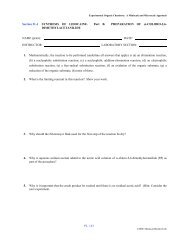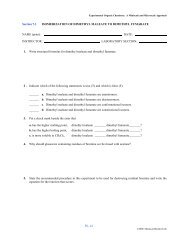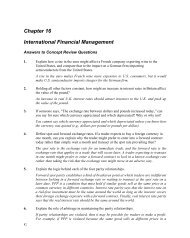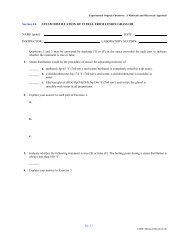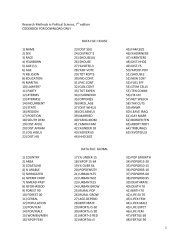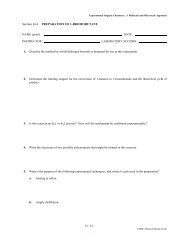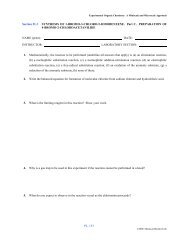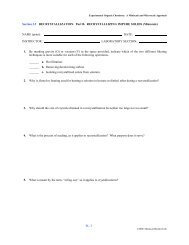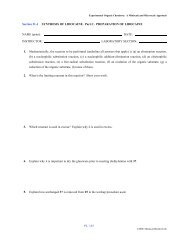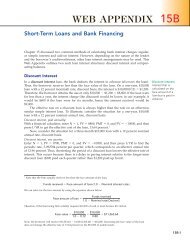ISOLATION OF TRIMYRISTIN FROM NUTMEG (Microscale)
ISOLATION OF TRIMYRISTIN FROM NUTMEG (Microscale)
ISOLATION OF TRIMYRISTIN FROM NUTMEG (Microscale)
Create successful ePaper yourself
Turn your PDF publications into a flip-book with our unique Google optimized e-Paper software.
Experimental Organic Chemistry: A Miniscale and <strong>Microscale</strong> Approach<br />
Section 5.4<br />
<strong>ISOLATION</strong> <strong>OF</strong> <strong>TRIMYRISTIN</strong> <strong>FROM</strong> <strong>NUTMEG</strong> (<strong>Microscale</strong>)<br />
NAME (print):<br />
DATE:<br />
INSTRUCTOR:<br />
LABORATORY SECTION:<br />
1. The technique responsible for isolation of trimyristin in this experiment is an example of (check one)<br />
liquid-liquid, solid-liquid, gas-liquid extraction.<br />
2. Indicate which of the following statements is true (T) and which is false (F).<br />
a. Pure trimyristin is a liquid at room temperature.<br />
b. According to the equation defining the distribution coefficient K, a value of 2 for K<br />
means that A is more soluble in solvent S o than in solvent S x<br />
K = grams of A in S x<br />
grams of A in S o<br />
x mL of S o<br />
mL of S x<br />
c. Nutmeg contains a complex mixture of organic compounds that are soluble in diethyl<br />
ether.<br />
d. Trimyristin is more soluble in acetone than in diethyl ether.<br />
e. The functional group present in trimyristin is a carboxylic acid group.<br />
f. The term lipid describes a category of organic compounds that are insoluble in water.<br />
g. With respect to the technique of extraction, the term partitioning means physical<br />
separation of two immiscible phases by an impermeable membrane.<br />
3. Explain your answer to Exercises 2e and 2f.<br />
e.<br />
f.<br />
PL. 27<br />
©2006 Thomson Brooks/Cole
Experimental Organic Chemistry: A Miniscale and <strong>Microscale</strong> Approach<br />
4. Why is trimyristin considered a saturated fat?<br />
5. What is wrong with the experimental set-up shown below for extraction of nutmeg?<br />
Water in<br />
Water out<br />
6. On the figure shown in Exercise 5, indicate on the condenser the upper limit for the ring of condensate and the<br />
point at which a clamp should be located.<br />
7. Why is a flame not to be used to heat diethyl ether at reflux in this experiment?<br />
8. What would the consequence be of not having the condenser tightly connected to the conical vial during the<br />
reflux period?<br />
9. The flash point (°C) of diethyl ether is ; that of acetone is .<br />
10. List possible effects of inhaling excessive amounts of diethyl ether.<br />
PL. 28<br />
©2006 Thomson Brooks/Cole




